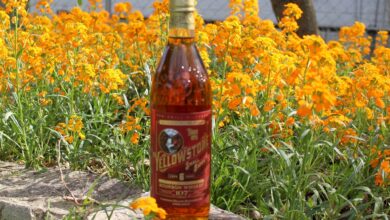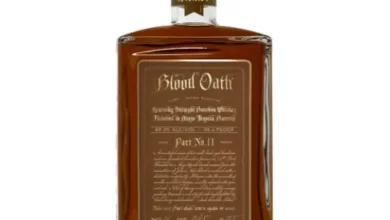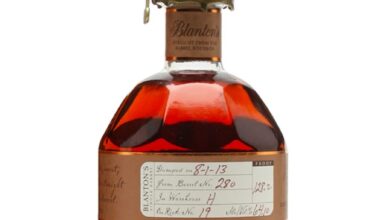Green Spot Irish Whiskey Review
Updated November 20, 2024
By Richard Thomas
Average Rating: B+

(Credit: Irish Distillers)
Concurrent with the renewed interest in Irish whiskeys is a rise in popularity for single pot still whiskeys among the enthusiast set, and when you are talking single pot still, two brands inevitably dominate discussion: Redbreast and “the Spots.” I find the Spots (Green Spot, Yellow Spot and others) come up almost as often as Redbreast, and that is odd when you consider how much harder to find the Spots are.
The Spots have their origin with Dublin’s Mitchell & Son wine merchants. No one is sure when these venerable negociants got into the whiskey trade, but documentation places it at least as far back as the 1920s. The origin of the name applied to the Spots comes from the way the barrels were tagged with a daub of paint, color coded to particular age ranges.
Eventually Mitchell & Sons turned the process of blending and marrying the pot still whiskeys over to their supplier, Midleton, and the Spots survived the nadir of the Irish whiskey industry to become one of the very few bonded Irish whiskeys, and the only one made for an independent bottler. In Ireland, the Spots are still sold by Mitchell & Son, but elsewhere they are sold by Pernod Ricard, Midleton’s parent company.
The Whiskey
Green Spot is the entry-level run of the pair of surviving Spots, made from 7 to 10 year old pot still whiskeys aged in first- and second-fill bourbon barrels and ex-sherry casks. The whiskey is bottled at 40% abv (80 proof).
The scent lies in just the right spot (no pun intended), where malty honey, peppermint, and a toasty, oaky vanilla are all evenly balanced. From there, the flavor continues and grows. The pot still whiskey spiciness expresses itself as a mix of orange zest and cloves, wrapped in caramel and rounded out by a tinge of earthy woodiness, all on a creamy texture. The finish is long, but restrained with only a mild spicy afterglow.
Addendum By John Rayls
Green Spot Irish Whiskey has a beautiful hue combination of soft orange and yellow gold in both the bottle and the glass. As the light penetrates and reflects, it creates an illusion of a crisp Fall New England day. It truly is a beautiful whiskey to observe. The legs are long and very slow to appear. However once there, they seem to go on forever.
The nose is very subtle (as I find most Irish whiskeys). You may notice notes of cereal and fresh fruit over a very subtle sweet oak. There is some complexity present, but you’ll need a strong commitment to the process to experience it.
Midleton believes the taste to be a full spicy body with a hint of cloves along with fruity sweetness of green apples rounded off with toasted oak, and, surprisingly, I agree. Initially, the light creamy coating of the mouth will draw you in as you begin to experience the sweet green apple taste over a light sweet oak. A more aggressive, but pleasant spiciness soon replaces the fruit experience. The spice is almost reluctant, but eventually leads to a long, enjoyable finish filled with cloves and other hints of spice.
At 80 proof, this is a very drinkable, well-balanced whiskey, smooth without being dull. It is a subtle whiskey in all regards, except for, possibly, the finish. For my part, I would hate to miss any part of the experience, so my advice is that Green Spot Irish Whiskey deserves your full attention.
Addendum by Alex Southgate
To the eye, Green Spot is a soft honey in the glass. Fairly viscous on the pour, this whiskey evenly coats the glass leaving a clean line around the edge. This would give the impression of a heavier, oilier, whiskey but in this case that observation wouldn’t necessarily be true.
The nose is bursting with fruit. The scent is crisp and clean and the first aroma we are met with is one of green apples. These scents carry through to the finish but are met with the woody cinnamon. The finish is soft, creamy, barley.
The taste of Green Spot is as fruity as the nose. We get a punchy apple sourness which pairs nicely with a grapefruit tang that livens up the palate. To provide body and ground these sharper notes we have a long lasting finish of white pepper.
Generally I wouldn’t reach for very fruity whiskeys. There are two reasons for this. The first is that they can be a little one dimensional. This obviously depends on the different flavors being used, but when it’s different varieties of fruit I find myself looking for something else to help create balance. Secondly, some of these whiskeys can come over a little sweet or sickly after a while. You really need a modicum of sourness to break that and this is what I particularly like about Green Spot.
Green Spot has a very sharp, clean taste that I like. The creamier, peppery tones help to break this up and neutralize the palate ready for more. This being said, even though whiskeys that are very fruity aren’t usually my first choice, (I like savory tipples,) this is one that I would definitely add to my collection. As I mentioned earlier, I enjoyed Green Spot so much that I want to explore the range from Spot Whiskeys further. This in and of itself should speak volumes with regard to my grade.
The Price
In the United States, this item often hovers around $60, but pricing as high as $75 is not uncommon. In Europe, £45 or €55 is typical.





It’s a very tame whiskey that comes out as a brandy. The process must rely on some strong sherry casks to make a whiskey that tastes just like a brandy.
It’s also quite numbing, which I think the experts call cloves, so overall this would be an excellent whiskey for emergency surgical uses and topical anesthetic effects.
Nothing against Mr Thomas but I have to agree more fully with the comments by Father Rayls. I believe he would have scored it a bit higher were it his purview. This is a very fine whiskey with an overall delicacy and yet a sufficient sting to let the drinker know it is whiskey and nothing else. I can’t seem to put my finger on what makes this taste different with each sip. A little more air, a push to the rear or sides, and the sip becomes a different experience. I would push this at least to a B+ myself if not slightly higher, and would note that other tasting reviews have this at a 93/100. It has the creaminess of the Very Rare Irish which says quite a lot.